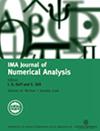Allen-Cahn方程任意高阶ETD龙格-库塔格式的最大界原理和原始能量耗散
IF 2.4
2区 数学
Q1 MATHEMATICS, APPLIED
引用次数: 0
摘要
能量耗散规律和最大界原理是Allen-Cahn方程的两个基本物理性质。虽然已知许多现有的时间步进方法保留了能量耗散规律,但大多数方法适用于一种修正形式的能量。本文证明了当Allen-Cahn方程的非线性项为Lipschitz连续时,一类具有线性稳定技术的任意高阶指数型时差分龙格-库塔格式在一定步长约束下保持了原有的能量耗散特性。为了保证非线性项上的Lipschitz条件,我们引入了一种重尺度后处理技术,保证数值解无条件地满足最大界原理。因此,我们提出的方案同时保持了原始能量耗散规律和最大界原理,同时实现了任意高阶精度。我们还建立了所提方案的最优误差估计。数值实验充分证实了高阶格式的收敛速度、最大界原理和原始能量耗散特性的保持以及长时间模拟的高效率。本文章由计算机程序翻译,如有差异,请以英文原文为准。
Maximum bound principle and original energy dissipation of arbitrarily high-order ETD Runge–Kutta schemes for Allen–Cahn equations
The energy dissipation law and the maximum bound principle are two fundamental physical properties of the Allen–Cahn equations. While many existing time-stepping methods are known to preserve the energy dissipation law most of them apply to a modified form of energy. In this work we show that, when the nonlinear term of the Allen–Cahn equation is Lipschitz continuous, a class of arbitrarily high-order exponential time differencing Runge–Kutta schemes with the linear stabilization technique preserves the original energy dissipation property under some step-size constraint. To ensure the Lipschitz condition on the nonlinear term we introduce a rescaling post-processing technique, which guarantees that the numerical solution unconditionally satisfies the maximum bound principle. As a result, our proposed schemes simultaneously maintain both the original energy dissipation law and the maximum bound principle while achieving arbitrarily high-order accuracy. We also establish the optimal error estimate for the proposed schemes. Numerical experiments fully confirm the convergence rates, the preservation of the maximum bound principle and the original energy dissipation property, as well as the high efficiency of the high-order schemes for long-time simulations.
求助全文
通过发布文献求助,成功后即可免费获取论文全文。
去求助
来源期刊
CiteScore
5.30
自引率
4.80%
发文量
79
审稿时长
6-12 weeks
期刊介绍:
The IMA Journal of Numerical Analysis (IMAJNA) publishes original contributions to all fields of numerical analysis; articles will be accepted which treat the theory, development or use of practical algorithms and interactions between these aspects. Occasional survey articles are also published.

 求助内容:
求助内容: 应助结果提醒方式:
应助结果提醒方式:


